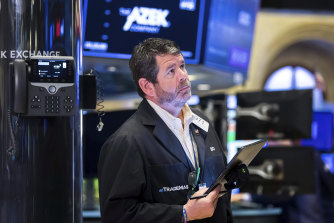ASX edges higher but energy stocks limit gains as oil falls
By Lachlan Abbott
The Australian sharemarket has edged higher following a flat start, with falling oil prices hitting energy stocks and offsetting mining sector rises on the ASX’s last day before earnings season begins next week.
The benchmark S&P/ASX 200 was 0.4 per cent higher in morning trade and sat at 7,000.1 points at 11.55am AEST on Friday.

The energy sector fell by 2.1 per cent, with the Brent crude oil price down again overnight from about $US97 ($139) a barrel on Thursday to $US94 a barrel on Friday morning. Australian oil and gas producer Woodside moved 2.3 per cent downwards to $30.80, while Beach Energy declined by 3.4 per cent.
The mining sector posted the strongest gains for an individual sector, edging 1.3 per cent higher despite broadly following the energy sector downwards earlier this week as commodity prices softened. Iron ore majors BHP, Fortescue and Rio Tinto all added more than 1.2 per cent, despite iron ore futures dropping by another 3.5 per cent overnight to hit $US106.5 a tonne on Friday morning.
The lifters: Novanix +9.2%, Life360 +7.7%, Pointsbet +5%
The laggards: Whitehaven Coal -4.8%, Beach Energy -3.4%, Ampol -3.3%
Critical mineral miner Core Lithium moved 6.2 per cent higher to $1.29 in morning trade after announcing the appointment of new chief executive Gareth Manderson, who previously spent 22 years at Rio Tinto. Diversified miner South32 was also up 2 per cent, while lithium major Pilbara Minerals also enjoyed a 2.7 per cent climb.
Elsewhere, Block – which purchased Afterpay for $39 billion earlier this year – fell by 6.1 per cent this morning after reporting earnings earlier this morning in the United States. The fintech company founded by Twitter creator Jack Dorsey managed to just beat analyst expectations, but quarterly revenue was still down by 6 per cent to $US4.4 billion.
US stocks gave back some of their recent gains Thursday as a choppy day of trading on Wall Street ended with a mixed finish for the major indexes.
The S&P 500 closed 0.1 per cent lower after wavering between small gains and losses. The Dow Jones Industrial Average fell 0.3 per cent, while the Nasdaq rose 0.4 per cent.
Energy stocks, the biggest gainers in the benchmark S&P 500 so far this year, were the biggest drag on the market as the price of US crude oil fell below $US90 per barrel for the first time since early February, before Russia’s invasion of Ukraine.
Gains in technology stocks, retailers and elsewhere helped keep the losses in energy, health care and other sectors in check.
The muted trading came as investors continued to review the latest updates on the economy and corporate earnings ahead of the government’s monthly snapshot of the nation’s job market Friday.
Investors are eyeing jobs data to gauge whether any tightening in the labour market might prompt the Federal Reserve to eventually ease up on its interest rate hikes as it fights inflation, potentially lessening the chance of the central bank bringing on a recession.
“They wanted to quell demand and temper inflation and they wanted to do so without unduly impacting the labor market in a negative way,” said Katie Nixon, chief investment officer for Northern Trust Wealth Management. “So far, the Fed is going to assess all of this as according to plan and they’re going to keep going.”
The S&P 500 slipped 3.23 points to 4,151.94, and the Dow dropped 85.68 points to 32,726.82. The Nasdaq rose 52.42 points to 12,720.58. The Russell 2000 index of smaller company stocks gave up 2.47 points, or 0.1 per cent, to close at 1,906.46.
All of the major indexes except for the Dow are on pace for weekly gains after rallying Wednesday.
The price of US crude oil fell 2.3 per cent to settle at $US88.54 per barrel Thursday, weighing on energy company stocks. Exxon Mobil slid 4.2 per cent and Occidental Petroleum fell 5.8 per cent.
Stocks have meandered this week, leaving major indexes mostly higher. August’s gain follows a standout July that was the S&P 500’s best month since late 2020. But markets remain volatile as investors try to determine the economy’s path ahead amid the highest inflation in four decades and efforts from central banks to fight higher prices.
The Federal Reserve has been aggressively raising interest rates to try and slow the economy and fight inflation, along with other central banks. The Bank of England on Thursday initiated its biggest rate hike in more than a quarter of a century.
Recent economic data from retail sales and employment reports has shown that the economy is already slowing down.
“The cure for high inflation is sometimes high inflation,” Nixon said. “The narrative that we might have been at or past peak inflation is being validated by some of the data coming out.”
Most Viewed in Business
Source: Thanks smh.com